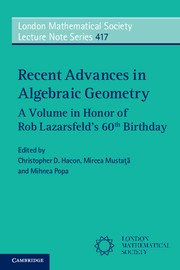Book contents
- Frontmatter
- Contents
- List of contributors
- Preface
- 1 The effect of points fattening in dimension three
- 2 Some remarks on surface moduli and determinants
- 3 Valuation spaces and multiplier ideals on singular varieties
- 4 Line arrangements modeling curves of high degree: Equations, syzygies, and secants
- 5 Rationally connected manifolds and semipositivity of the Ricci curvature
- 6 Subcanonical graded rings which are not Cohen–Macaulay
- 7 Threefold divisorial contractions to singularities of cE type
- 8 Special prime Fano fourfolds of degree 10 and index 2
- 9 Configuration spaces of complex and real spheres
- 10 Twenty points in ℙ3
- 11 The Betti table of a high-degree curve is asymptotically pure
- 12 Partial positivity: Geometry and cohomology of q-ample line bundles
- 13 Generic vanishing fails for singular varieties and in characteristic p > 0
- 14 Deformations of elliptic Calabi–Yau manifolds
- 15 Derived equivalence and non-vanishing loci II
- 16 The automorphism groups of Enriques surfaces covered by symmetric quartic surfaces
- 17 Lower-order asymptotics for Szegö and Toeplitz kernels under Hamiltonian circle actions
- 18 Gaussian maps and generic vanishing I: Subvarieties of abelian varieties
- 19 Torsion points on cohomology support loci: From D-modules to Simpson's theorem
- 20 Rational equivalence of 0-cycles on K3 surfaces and conjectures of Huybrechts and O'Grady
- References
19 - Torsion points on cohomology support loci: From D-modules to Simpson's theorem
Published online by Cambridge University Press: 05 January 2015
- Frontmatter
- Contents
- List of contributors
- Preface
- 1 The effect of points fattening in dimension three
- 2 Some remarks on surface moduli and determinants
- 3 Valuation spaces and multiplier ideals on singular varieties
- 4 Line arrangements modeling curves of high degree: Equations, syzygies, and secants
- 5 Rationally connected manifolds and semipositivity of the Ricci curvature
- 6 Subcanonical graded rings which are not Cohen–Macaulay
- 7 Threefold divisorial contractions to singularities of cE type
- 8 Special prime Fano fourfolds of degree 10 and index 2
- 9 Configuration spaces of complex and real spheres
- 10 Twenty points in ℙ3
- 11 The Betti table of a high-degree curve is asymptotically pure
- 12 Partial positivity: Geometry and cohomology of q-ample line bundles
- 13 Generic vanishing fails for singular varieties and in characteristic p > 0
- 14 Deformations of elliptic Calabi–Yau manifolds
- 15 Derived equivalence and non-vanishing loci II
- 16 The automorphism groups of Enriques surfaces covered by symmetric quartic surfaces
- 17 Lower-order asymptotics for Szegö and Toeplitz kernels under Hamiltonian circle actions
- 18 Gaussian maps and generic vanishing I: Subvarieties of abelian varieties
- 19 Torsion points on cohomology support loci: From D-modules to Simpson's theorem
- 20 Rational equivalence of 0-cycles on K3 surfaces and conjectures of Huybrechts and O'Grady
- References
Summary
Abstract
We study cohomology support loci of regular holonomic D-modules on complex abelian varieties, and obtain conditions under which each irreducible component of such a locus contains a torsion point. One case is that both the D-module and the corresponding perverse sheaf are defined over a number field; another case is that the D-module underlies a graded-polarizable mixed Hodge module with a ℤ-structure. As a consequence, we obtain a new proof for Simpson's result that Green–Lazarsfeld sets are translates of subtori bytorsion points.
1 Overview
1.1 Introduction
Let X be a projective complex manifold. In their two influential papers about the generic vanishing theorem [6, 7], Green and Lazarsfeld showed that the so-called cohomology support loci
are finite unions of translates of subtori of Pic0(X). Beauville and Catanese [2]conjectured that the translates are always by torsion points, and this was proved by Simpson [19] with the help of the Gelfond–Schneider theorem from transcendental number theory. There is also a proof using positive characteristic methods by Pink and Roessler [13].
Over the past 10 years, the results of Green and Lazarsfeld have been reinterpreted and generalized several times [8, 14, 17], and we now understand that they are consequences of a general theory of holonomic D-modules on abelian varieties. The purpose of this paper is to investigate under what conditions the result about torsion points on cohomology support loci remains true in that setting. One application is a new proof for the conjecture by Beauville and Catanese that does not use transcendental number theory or reduction to positive characteristic.
Note: In a recent preprint [20], Wang extends Theorem 1.4 to polarizable Hodge modules on compact complex tori; as a corollary, he proves the conjecture of Beauville and Catanese for arbitrary compact Kähler manifolds.
1.2 Cohomology support loci for D-modules
Let A be a complex abelian variety, and let M be a regular holonomic DA-module; recall that a D-module is called holonomic if its characteristic varietyis a union of Lagrangian subvarieties of the cotangent bundle.
- Type
- Chapter
- Information
- Recent Advances in Algebraic GeometryA Volume in Honor of Rob Lazarsfeld’s 60th Birthday, pp. 405 - 421Publisher: Cambridge University PressPrint publication year: 2015
References
- 2
- Cited by



